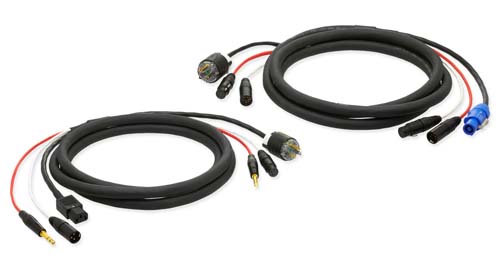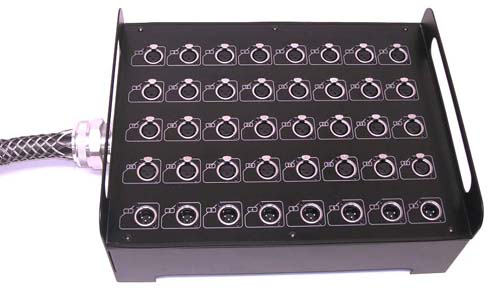
A good way to organize different types of cables is to loom them, or join them together into a bundle so you only run one bundle to an area. This works well for the signal and power cables for powered loudspeakers, as well as for a signal output or through-cable to run signal to another stage monitor.
Common methods include taping or heat shrinking the various cables together into a bundle or using expandable braided tubing, which is an outer jacket that is designed to protect and contain cable bundles.
Several manufacturers make multi-core cables with signal, loudspeaker, video, and even Cat-5/6 lines in the same jacket. Snakes incorporating signal and loudspeaker lines together in the same jacket are usually referred to as “power” snakes (even though they contain no AC power cables). These are great for use with powered mixers as main snakes and also as subsnakes for running signal and monitor loudspeaker lines to onstage musicians.
Multi-core cables/snakes with Cat lines come in handy for distributing signals to personal monitor mixers around a stage. One cool product that came out a few years ago is the InstaSnake from Energy Transformation Systems.
It consists of two boxes that connect via Cat-5/6, yet it also transmits four channels of analog audio up to 1,900 feet down the cable, and can be used with mic, line and even AES/EBU signals.
With a box of Cat cable, some connectors and a crimper, a custom-length 4-channel analog snake can be made onsite. (This is relatively inexpensive too.)
Manufacturers have been developing specific cables for powered loudspeakers and monitors, offering AC power and signal lines inside one jacket. For example, Gepco recently introduced the Touring Line of Run One Series loudspeaker cables that use larger gauge power conductors and an overall shield to help reduce outside noise.
For situations where a single mixer is used, the SB (Stage Box) audio distribution snake system from Link can come in handy. It consists of stage extensions that permit separate input and output channels by running one cable from the stage to the mixer (black color for mixer in and red for mixer out). The SB system incorporates multiple length individually shielded multipair cable from eurocable, and ends with a 100 cm fan-out protected by a “heat-shrink” jacket that maintains flexibility.
Compact SB versions are available with 8-, 12-, 16- and 20-channel fixed box snake systems, while large SB versions offer 32-, 40-, and 48-channel versions. All are available for a variety of input/output combinations.
Options Abound
Loudspeaker cables can also benefit from organization. They can be labeled by color and/or number for quick ID and sorting. My company also provides backline and A/V services in addition to audio, so we have both 1/4-inch loudspeaker cables and 1/4-inch signal cables in our inventory.
To make sure they’re not used incorrectly, we put color shrink wrap over the plugs on the cables, using yellow for loudspeaker lines and red for signal. Patterned after traffic lights, the yellow warns that the loudspeaker cable will cause a hum if used as a guitar cable, and the red color says STOP, this cable will not handle the output from a backline amplifier.


